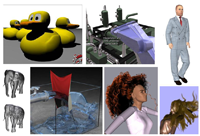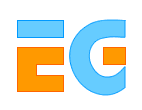T13Collision Handling and its Applications

- Organizer
- Matthias Teschner, Freiburg University
- Speakers
- Matthias Teschner, Freiburg University
Marie-Paule Cani, INP Grenoble
Ron Fedkiw, Stanford University, USA
Stephane Redon, INRIA Rhone-Alpes, France
Pascal Volino, University of Geneva, Switzerland
Gabriel Zachmann, Clausthal University, Germany
Robert Bridson, University of British Columbia
- Abstract
- This tutorial discusses collision detection and response algorithms
with a special emphasis on a wide range of applications,
such as rigid objects, deformable objects, cloth, hair,
point clouds and fluids. On one hand, the tutorial illustrates
common aspects of collision handling approaches in these
application areas. On the other hand, unique requirements
of each application are outlined. The presentation of a variety
of solution strategies for collision handling problems in
terms of specific applications provides the participants of the
tutorial with the ability to evaluate existing techniques in the
context of their own application.
- Speakers' Background
-
- Matthias Teschner
- received the PhD degree in Electrical Engineering
from the University of Erlangen-Nuremberg in
2000. From 2001 to 2004, he was research associate at Stanford
University and at the ETH Zurich. Currently, he is
professor of Computer Science and head of the Computer
Graphics group at the University of Freiburg. His research
interests comprise real-time rendering, scientific computing,
physical simulation, computer animation, computational geometry,
collision handling, and human perception of motion.
His research is particularly focused on real-time physicallybased
modeling of interacting deformable objects and fluids
with applications in entertainment technology and medical
simulation. Matthias Teschner has contributed to the field of
physically-based modeling and collision handling in several
papers. At Eurographics 2004, he organized a State-of-the-
Art report on collision detection. At IEEE VR 2005 and Eurographics
2005 he participated and organized tutorials on
collision detection and collision handling.
- Marie-Paule Cani
- is a full Professor of Computer Science
at the INPG, France. A graduate from the Ecole Normale
Suprieure, she received a PhD in Computer Science from
the University of Paris Sud in 1990, and was elected member
of the Institut Universitaire de France (IUF) in 1999.
She is vice-director of the research lab GRAVIR (Computer
GRAphics, Computer VIsion and Robotics), a joint lab of
CNRS, INPG, INRIA and UJF, where she leads the research
group EVASION, created in 2003. Her main research interests
cover physically-based simulation, implicit surfaces
applied to interactive modeling and animation and the design
of layered models incorporating alternative representations
and LODs. Recent applications include the animation
of natural phenomena and virtual humans, real-time virtual
surgery and interactive sculpting techniques. Marie-Paule
Cani was paper co-chair of Eurographics 04, is co-chairing
Shape Modeling International 2005 and has served in the
program committee of major graphics conferences, including
SIGGRAPH in 2001 and 2005.
- Ron Fedkiw
- received his Ph.D. in Mathematics from
UCLA in 1996 and did postdoctoral studies both at UCLA
in Mathematics and at Caltech in Aeronautics before joining
the Stanford Computer Science Department. He was
awarded the National Academy of Science Award for Initiatives
in Research, a Packard Foundation Fellowship, a Presidential
Early Career Award for Scientists and Engineers
(PECASE), a Sloan Research Fellowship, the ACM Siggraph
Significant New Researcher Award, an Office of Naval
Research Young Investigator Program Award (ONR YIP),
a Robert N. Noyce Family Faculty Scholarship, two distinguished
teaching awards, etc. Currently he is on the editorial
board of the Journal of Computational Physics, Journal of
Scientific Computing, IEEE Transactions on Visualization
and Computer Graphics, and Communications in Mathematical
Sciences, and he participates in the reviewing process of
a number of journals and funding agencies. He has published
over 60 research papers in computational physics, computer
graphics and vision, as well as a book on level set methods.
For the past five years, he has been a consultant with Industrial
Light + Magic. He received screen credits for his work
on "Terminator 3: Rise of the Machines" and "Star Wars:
Episode III - Revenge of the Sith".
- Stephane Redon
- is a Research Scientist at INRIA Rhone-
Alpes, working with Dr. Sabine Coquillart in the i3D research
team. He graduated from Ecole Polytechnique in
1998, and received his M.S. in 1999 from Pierre and Marie
Curie University, France. He received a Ph.D. in Computer
Science in 2002 from INRIA Rocquencourt - Evry University,
France, while working with Dr. Sabine Coquillart and
Prof. Abderrahmane Kheddar on robust interactive simulation
of rigid body systems and its applications to virtual prototyping
and animation. He spent two years in the Department
of Computer Science of the University of North Carolina
at Chapel Hill as a Post-Doctoral Research Associate,
working with Prof. Ming C. Lin in the GAMMA research
team. His research interests include the design of robust and
realistic real-time virtual environments, collision detection,
haptics, motion planning, simulation levels of detail, and 3d
interaction. His current research is centered on the development
of scalable algorithms for interactive simulation and
control of complex dynamical systems.
- Pascal Volino
- is a computer scientist, working at MIRAlab,
University of Geneva. He is actually working on new
models for cloth animation, involving versatile models for
efficient simulations on situations involving high deformation,
wrinkling and multilayer garments. The research is particularly
focused on data structure, efficient collision detection,
robust simulation and interactive cloth manipulation.
- Gabriel Zachmann
- is professor for computer graphics at
Clasuthal University since 2005. Prior to that, he was assistant
professor with the computer graphics group at Bonn
University. He received a PhD in computer science from
Darmstadt University in 2000. From 1994 until 2001, he
was with the virtual reality group at the Fraunhofer Institute
for Computer Graphics in Darmstadt, where he carried
out many industrial projects in the area of virtual prototyping.
Zachmann has published many papers at international
conferences in areas like collision detection, virtual prototyping,
intuitive interaction, mesh processing, and camerabased
hand tracking. He has also served on various international
program committees.
- Robert Bridson
- received his Ph.D. in Scientific Computing and
Computational Mathematics in 2003 at Stanford University
before arriving at UBC. He has published several computer
graphics papers on physics-based animation, from fluids to
cloth, as well as a number of scientific computing
papers, and is currently writing a book on physics-based
animation for Cambridge University Press. He codeveloped
physics-based animation software for feature film visual
effects in use at Industrial Light + Magic and elsewhere,
and has also consulted at Sony Pictures ImageWorks.
If you have any comments regarding this webpage please send a message to the webmaster.
























